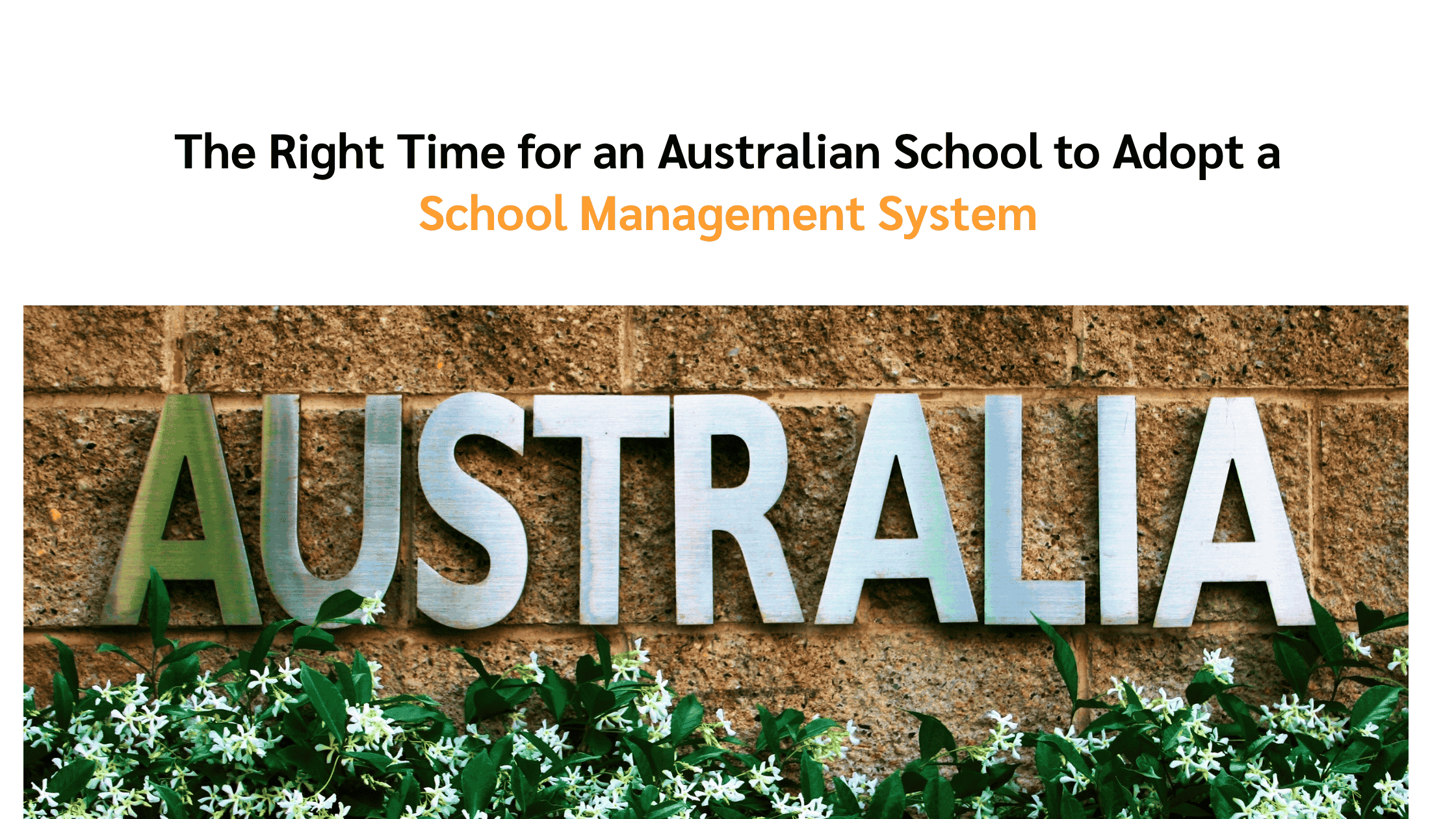Discover student orientation insights, tips, and strategies from experts
Guide to effective student orientations
Download the eBook




Australian principals and business managers often ask the same question: when is the right moment to move from spreadsheets and disconnected tools to a unified platform? A modern school management system Australia leaders choose is more than software. It is the operational backbone that keeps compliance, communication and teaching aligned across state based frameworks.
Waiting too long adds risk. National attendance for Years 1–10 sat at 88.3 per cent in 2024 and only 59.8 per cent of students reached the 90 per cent benchmark, so manual processes leave intervention opportunities on the table. At the same time Victorian and national reviews highlight unsustainable administrative burdens and a growing need to use data better for wellbeing and NAPLAN improvement.
This guide explains the concrete readiness signals and calendar triggers that tell an Australian school it is time to adopt. We blend Department of Education statistics, state policy shifts and insights we have shared on LinkedIn - including our post that noted, “When schools talk in the channel and language families choose, engagement jumps and admin noise drops.”
Use the sections below to assess your current state, minimise disruption and plan a successful implementation window.
Implementing a platform is not just a technology purchase. It is the point where a school replaces piecemeal systems with Australian school management software that aligns with the:
-> Australian Curriculum
-> ACARA data exports
-> State attendance codes.
A true student information system Australia schools rely on holds enrolments, rolls, behaviour, NAPLAN results, finance and communication in one secure database. Adoption shifts staff workflows from reactive, paper based tasks toward proactive monitoring with analytics, automated alerts and audit trails. It also sets the foundation for AI assisted features and school technology solutions Australia authorities are beginning to promote through workload reduction agendas.
Leaders often notice an inflection point before adoption: the moment a timetable change requires editing three different systems or a parent privacy complaint emerges because a spreadsheet was emailed to the wrong address. At that point the cost of inaction quietly exceeds the subscription fee. A school management system Australia ready vendors provide replaces that hidden complexity. Because updates, backups and security patches are managed centrally, internal ICT staff can redirect energy toward coaching teachers on meaningful data use instead of maintaining servers.
How many times do staff rekey the same student name into different tools? If enrolment, attendance, behaviour and finance sit in silos, compliance evidence takes hours. The Australian Education Regulation requires approved authorities to keep enrolment and attendance records for seven years. When records are scattered the risk of error or privacy breach rises.
National attendance figures - 88.3 per cent overall and 59.8 per cent of students meeting the 90 per cent benchmark - show why delays matter. In an integrated environment an administrator filters by date, exports a report and attaches timestamped communication logs in minutes. A school management system Australia wide becomes both shield and microscope: it protects data and reveals patterns quickly.
Victorian reviews and workload announcements emphasise freeing teachers from paperwork so they can teach. When leaders see teachers or office staff spending large portions of the week on manual enrolment packs, fee reconciliation or attendance follow up, the timing is right.
Automated online forms, integrated payments and communication templates inside school administration software Australia schools deploy convert hours of manual double handling into minutes. That reclaimed time supports mentoring, intervention groups and curriculum planning rather than clerical repetition. Workload statistics are not abstract. Every hour spent manually reconciling paid excursions is an hour not spent differentiating instruction.
Victorian reform announcements explicitly tie workload reduction to student outcomes, so investing early strengthens future funding arguments by demonstrating alignment with policy direction. As processes standardise inside the platform you can quantify labour savings, reinforcing the internal business case and supporting board oversight.

Sign 3: Parent engagement gaps are widening
In New South Wales more than a third of students come from homes where languages other than English are spoken. Paper notices or one way emails rarely meet the preferences of multilingual, mobile families. If attendance follow up takes multiple phone calls or newsletters are ignored, your timing signal is clear. An education management system Australia families use centralises messaging across SMS, app and email with translation support. Two way threads stored against the student record improve transparency and reduce duplicated calls. Parent sentiment also shifts when response times improve. Instead of leaving voicemails during office hours, families can acknowledge an absence notification from their phone on a worksite.
When communications move through one audited channel the school can analyse open rates and iterate tone just as a business would refine customer engagement.
Teachers want to act before a NAPLAN or progress report becomes an issue. If assessment results, attendance, wellbeing notes and adjustments sit in different applications, staff rely on anecdotes. A consolidated student information system Australia context delivers merges those data streams and visualises growth and risk. When you cannot easily identify students dipping below 90 per cent attendance who also show literacy concerns, adoption is overdue. Early intervention thrives on longitudinal data.
Over a term, small dips in formative assessments may be invisible to individual teachers. Unified dashboards aggregate those signals across subjects and flag compound risk factors.
For example: a Year 6 student with falling writing scores, increased late arrivals and a wellbeing note appears high on an intervention list. Teachers schedule support earlier, families are engaged with clear evidence and progress is tracked objectively. This cycle is difficult to reproduce manually because data arrives at different times and in incompatible formats.
Schools across Australia are exploring AI assisted workflows to flag at risk students or draft communication. Legacy desktop databases, multiple logins and lack of APIs make it hard to plug in emerging educational software Australia innovators release. If upgrades require on site technicians or staff cannot access rolls securely off campus, the infrastructure clock has expired. A cloud platform with open APIs and single sign on creates a launchpad for future enhancements without further upheaval.
Technology readiness also includes culture. Staff cannot experiment with AI driven translation or predictive attendance models if they fear breaking brittle legacy software.
Replacing fragmented tools with a stable base lowers that anxiety. It also enables iterative improvement: modules can be enabled gradually and measured, rather than attempting a risky all-at-once revolution that drains goodwill.
Once readiness signals appear, timing controls risk and adoption success. Many Australian schools target a late Term 3 decision with implementation across Term 4 for a Term 1 go live. This schedule allows data cleansing, staff training and parallel runs without disrupting peak assessment or reporting periods. Regional schools may prefer a Term 2 build to avoid winter illness disruptions. The key is aligning migration milestones with your reporting cycle so old and new systems overlap long enough to validate accuracy.
Successful adoption begins with a rigorous audit. Catalogue every spreadsheet, access database and cloud app holding student or staff records. Standardise naming conventions and resolve duplicates before import. Nominate data owners in each functional area - enrolment, finance, wellbeing - so decisions have clear accountability. Engage unions or staff groups early by demonstrating how automation reduces administrative noise, echoing public commitments to workload relief.
Stakeholder confidence increases when leadership shows external validation. In our recent LinkedIn discussion GR Tech shared: “When schools talk in the channel and language families choose, engagement jumps and admin noise drops.” Quoting independent insights helps frame the system as a response to sector wide trends rather than an imposed IT project. Share early wins - such as reduced absent follow up time - through internal newsletters to reinforce momentum.
A typical adoption progresses through discovery, configuration, migration, training and go live. Discovery documents workflows and pain points. Configuration maps Australian Curriculum outcomes, attendance codes and role permissions. Migration imports cleansed historical data while staff shadow tasks in the new environment. Training is role based: classroom teachers experience roll marking, assessment entry and messaging while business managers focus on finance and reporting.
Go live should include a freeze on structural changes for several weeks to stabilise support volumes. A school management system Australia accelerates adoption. Select a school management system Australia early.
Define key metrics before switching off legacy systems. Common indicators include reduction in average attendance follow up time, teacher administrative hours saved and parent portal adoption rate. Attendance rates and intervention response times should improve within the first term because alerts surface earlier. Finance teams can track manual reconciliation hours and printing costs to demonstrate return on investment. Dashboards created inside the platform support evidence based reporting to boards and councils.
Deferring adoption compounds compliance and wellbeing risks. As absenteeism concerns grow and governments act on workload reviews, schools lacking integrated data may struggle to demonstrate proactive strategies. Manual processes increase the chance of privacy breaches when sensitive spreadsheets circulate via email. Delay also limits the ability to pilot AI tools responsibly because fragmented infrastructure cannot supply the secure, structured data they require.
Leaders often hear concerns about cost, disruption or staff capacity. Timing the project during a lower intensity term and using phased module rollouts reduces change fatigue. Cloud delivery removes major capital expenditure and Australian hosting with audit trails answers privacy questions. Role based training, micro videos and quick reference guides keep learning accessible. Most importantly, a balanced showcase of early wins maintains trust that the platform reduces workload rather than adding complexity.
If you recognise most of these conditions, the right time has arrived: your attendance data lives in multiple places and audits are slow, teachers report mounting administrative fatigue, parent communication requires manual translation or repeated phone calls, intervention conversations rely on anecdotes more than evidence and legacy tools block AI experimentation. In that scenario a school management system Australia schools implement will address root causes rather than symptoms. Couple those with a clear calendar window and board support and you have a low risk path to implement. Conversely if only one signal appears sporadically, invest first in data hygiene and process mapping so the eventual transition is cleaner.
Adopting a school management system Australia schools can trust is about timing decisions when readiness signals align with a manageable implementation window. By acting before fragmentation, workload or absenteeism escalate further, you protect staff wellbeing and student outcomes. With unified data, AI assisted tools and secure infrastructure in place your school is prepared for whatever regulatory changes 2026 delivers.